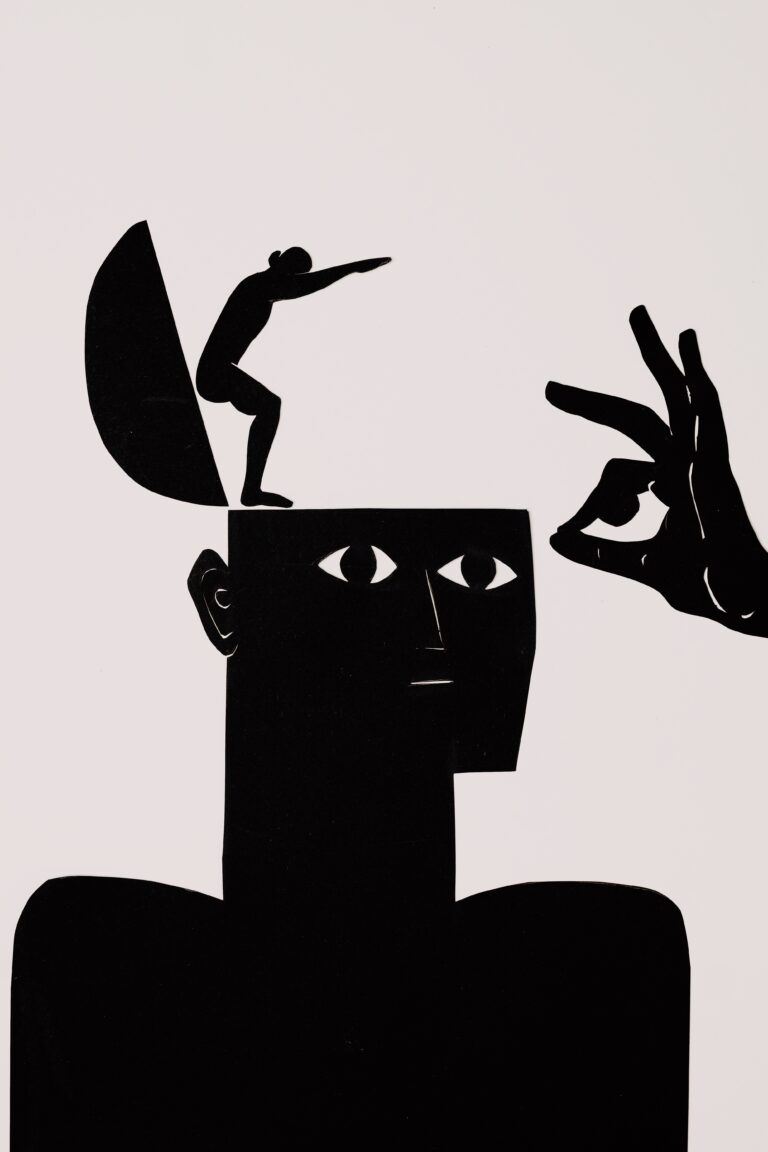
When we’re anxious, it disrupts our logical thinking ability.
I recently read Brianna Wiest’s book The Mountain is You, which explores various ways we self-sabotage. In it, she claims it’s not overthinking that causes anxiety, but rather under-thinking.
“Most of the anxiety you experience in life is the result in inefficient critical-thinking skills. You might assume that because you are anxious, you are an overthinker, someone who obsesses about unlikely and scary outcomes more than is reasonable. The reality is you are an under-thinker. You’re missing a part of your reasoning process.” – Brianna Wiest
When I first read this, I was surprised and even a bit offended. What!? But I am a logical, reasoning person AND I have anxiety – I thought.
However, after some reflection and research, I now agree with her perspective.
What is a Logical Lapse?
According to Wiest’s book, ‘logical lapses’ create profound anxiety. There are gaps in thinking clearly and reasonably about a situation. Instead, you continually obsess over an unwanted outcome.
For example, say you’re worried about giving a public speech. When you experience a logical lapse, all you can think about is the worst case scenario – such as stumbling upon your words.
You assume that you would panic. You keep obsessing over the same unwanted image of yourself freezing up. Fear keeps you from thinking through the rest of the scenario in a clear, logical way.

Anxiety Makes You Not Think Clearly
Fixating on the worst case scenario turns on your brain’s fight-or-flight response. Your body then reacts as if it’s under threat. This makes it near impossible to think clearly or reasonably about the situation.
You get tunnel vision and don’t trust yourself to handle a stressful outcome.
Additionally, when we try to resist these anxious feelings, it only makes things worse. Resisting our fear further intensifies this negative mental loop. Here’s why you should stop fighting with anxiety.
So what’s the solution? How do we stop these logical lapses?
4 Ways to Stop Anxiety from Hijacking Your Logical Thinking Ability:

#1 – Exposure
According to Brianna Wiest, exposure is the most common way to overcome anxiety. Irrational fears cause irrational thinking, which creates anxiety. Exposure is an effective way to unmask our irrational fears so they no longer control us.
Exposure means reintroducing the stressor into your life in a safe, gradual way. It may be uncomfortable at first, but eventually you’ll prove to yourself that you can handle the unwanted situation. Of course, if your anxiety is severe, you should seek the help of a licensed therapist.
Take baby steps in exposing yourself to your fears. It’s not all or nothing. Exposure will likely trigger a painful emotional response. Learning to process these emotions in a healthy way is the key to healing them. Learn more: How to Mindfully Embrace Negative Emotions.

#2 – Dale Carnegie’s ‘Magical Formula for Solving Worry Situations’
“True peace of mind comes from accepting the worst. Psychologically, I think it means a release of energy.”
Lin Yu-Tang (The Importance of Living)
Dale Carnegie, best-selling author and self-improvement guru, wrote a book full of practical techniques for conquering worry: How to Stop Worrying and Start Living.
His technique, ‘A Magical Formula for Solving Worry Situations’ cuts to the root of illogical, fear-based thinking. You identify the worst case scenario that you’re afraid of and then decide to accept it.
At first, this might seem like an impossible thing to do. But we must remember that whether we accept something or not has no influence on whether it will actually happen.

By finding a way to accept it mentally, we can then proceed to focus on the possible solutions.
Although the worst will most likely not ever happen, coming up with ways how we would handle it if it did puts our mind at ease. It also gives us confidence in our ability to respond to stressful situations.
How to Use Dale Carnegie’s Formula:
- Step 1: Analyze the situation honestly and ask yourself, ‘What is the worst that can possibly happen?’
- Step 2: Get yourself to mentally accept the possibility of the worst case scenario.
- Step 3: Calmly proceed to improve upon the worst. Think of various ways you could deal with it if it were to happen. Think of how you could effectively handle it. Think of how you would be able to move on with your life after.
That’s it! Seems overly simple? I urge you to try it before you bash it. Remember – it’s more effective to write this out on paper rather than just going through it in your head.
#3 – Fear Setting
“What we fear most is usually what we most need to do.”
Tim Ferris
I learned this technique from the best-selling author, entrepreneur, and podcaster, Tim Ferris. He says fear setting is the most valuable and powerful exercise that he does every month.
According to Tim, conquering fear starts with first defining your fear. We can’t heal what we’re not even aware of. Anxiety becomes less scary when we start to understand the causes behind it.

How to Do Fear Setting:
The below steps are my own version of his technique. You can read Tim’s original technique here, which is geared more towards conquering fear around taking action.
(Remember it’s more effective to actually write out your answers on paper or a digital document.)
- Step 1: Write down and clearly define the worst-case scenario that you’re anxious about. Write out your doubts, fears, and ‘what-if’ questions.
- Step 2: Answer: What steps could you take to cope with this scenario or repair the damage if it were to happen?
- Step 3: Define other, more likely outcomes. Also, think of some positive outcomes that could result from taking the action you want to, despite the risk of the worst case scenario happening (ex. More confidence, self-esteem, etc.).
- Step 4: Answer: If this worst-case scenario were to happen today, what would you do to handle it?
- Step 5: Answer: What are you putting off out of fear? What action should you be taking, that will move you forward, but are letting fear get in the way?
- Step 6: Answer: What is inaction costing you? What are you losing by not taking the necessary action that will propel you forward? Define what it’s costing you (physically, emotionally, financially) to postpone action.
Also check out Tim Ferris’s awesome TED talk where he shares how fear setting has changed his life:
#4 – Identify Your Logical Lapses
“ Until you make the unconscious conscious, it will direct your life and you will call it fate.”
Carl Jung
This technique is also from Brianna Wiest’s The Mountain is You. To identify your logical lapses, first think of some things that you’re not afraid of, but many people are.
For example: flying in airplanes, skydiving, public speaking, being single, or even driving. You’re not afraid of them because you don’t have a logical lapse there.
You can visualize yourself in those situations handling it without freaking out. Even if the worst were to happen, you can think the situation through from beginning to end. You know what you would do and you have a plan.
But with a logical lapse, you lack this mental clarity. Learn to identify your logical lapses and regain your logical thinking ability.

How to Identify Your Logical Lapses:
- Step 1: Think of something scary that you’re not afraid of but many people are. Examples: skydiving, flying in airplanes, spiders, getting fired, driving a car etc.
- Step 2: Become aware of your thought process around it. Why aren’t you afraid of it?
- Step 3: Think of their worst case scenarios. Are you able to imagine yourself effectively handling them? For example, reflect on why does the thought of being in a plane crash not make panic? (This doesn’t mean that it doesn’t scare you) What thoughts do you think that keep you from panicking?
- Step 4: Now think of a situation that’s causing you anxiety. Compare your thinking habits around it to the previous situations (the scary situations you don’t have anxiety around).
- Step 5: Notice the where the gaps are missing in your logical thinking ability. Are you not thinking through to the end? What negative beliefs do you have about your ability to handle the worst case scenario?
Now use this new awareness to begin challenging your negative beliefs. Recall and apply the thinking processes you’ve used before to overcome other anxiety-provoking situations.

Closing Thoughts
In conclusion, anxiety disrupts our logical thinking ability because it triggers our brain’s flight-or-fight response. Our bodies then react like they’re under threat. This limits our ability to think clearly and reasonably.
But, you can start today to dispel fear by learning to respond to in a more effective and objective way. Use these techniques to become aware of the disruptive thought patterns causing you anxiety.
There are many scary things in life that will always be beyond our control. We must remember that the only thing we can control is how we choose to respond to each situation.
“Either way, mental strength is not just hoping that nothing ever goes wrong. It is believing that we have the capacity to handle it if it does. Maybe you don’t have that self-belief yet. That’s okay. It’s not something you’re born with; it’s something you build slowly and over time.”
Brianna Wiest (The Mountain is You)
So, don’t waste another moment lost in the fog of anxiety. Awareness is the first step to change. Define your worst fears and resolve to challenge them – one day and one small step at a time.
Thank you for reading my blog! I’d love to hear your thoughts in the comments below:
What do you think is the cause of your anxiety? What has helped you to cope with or overcome anxiety?
Also, please share on Pinterest:







